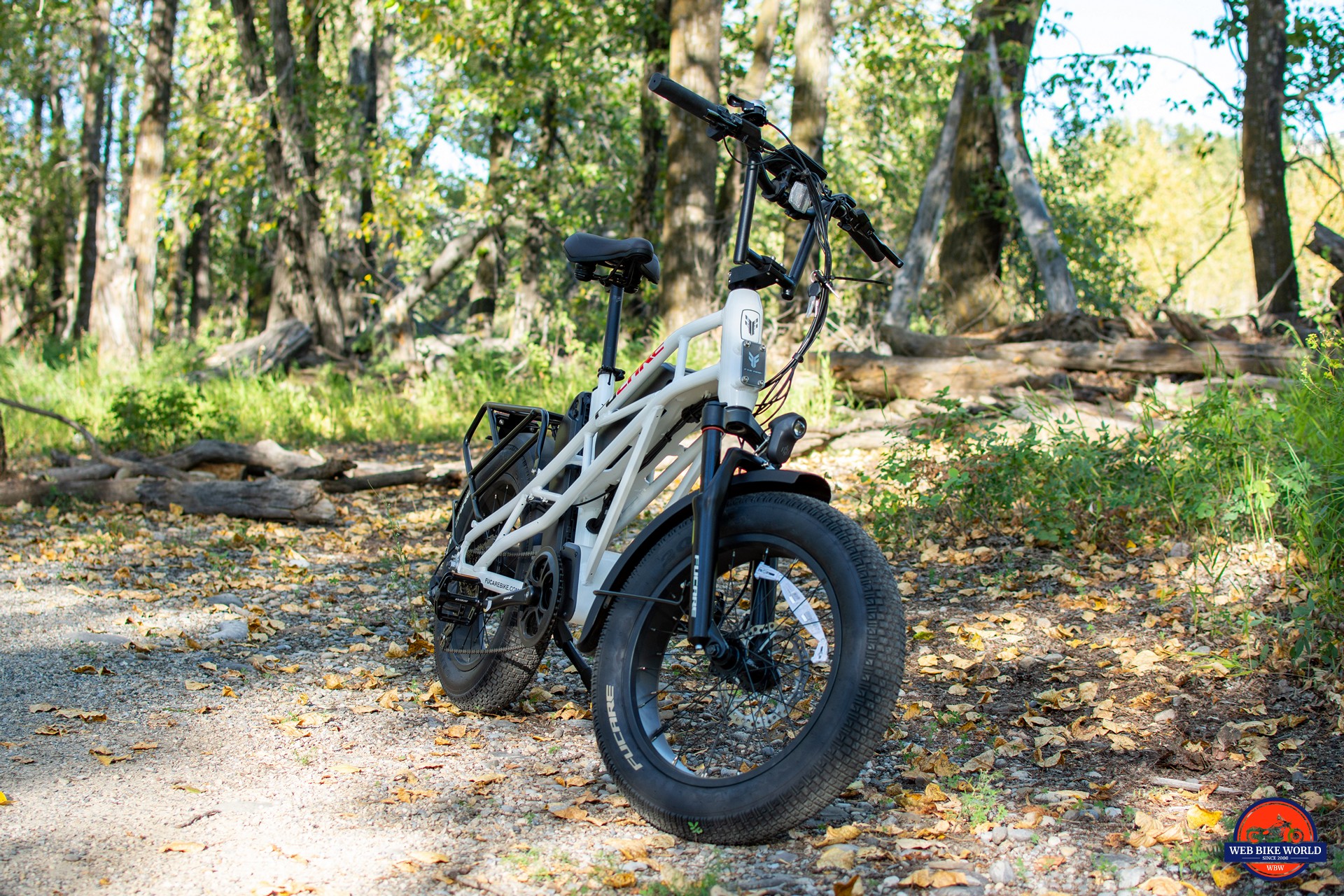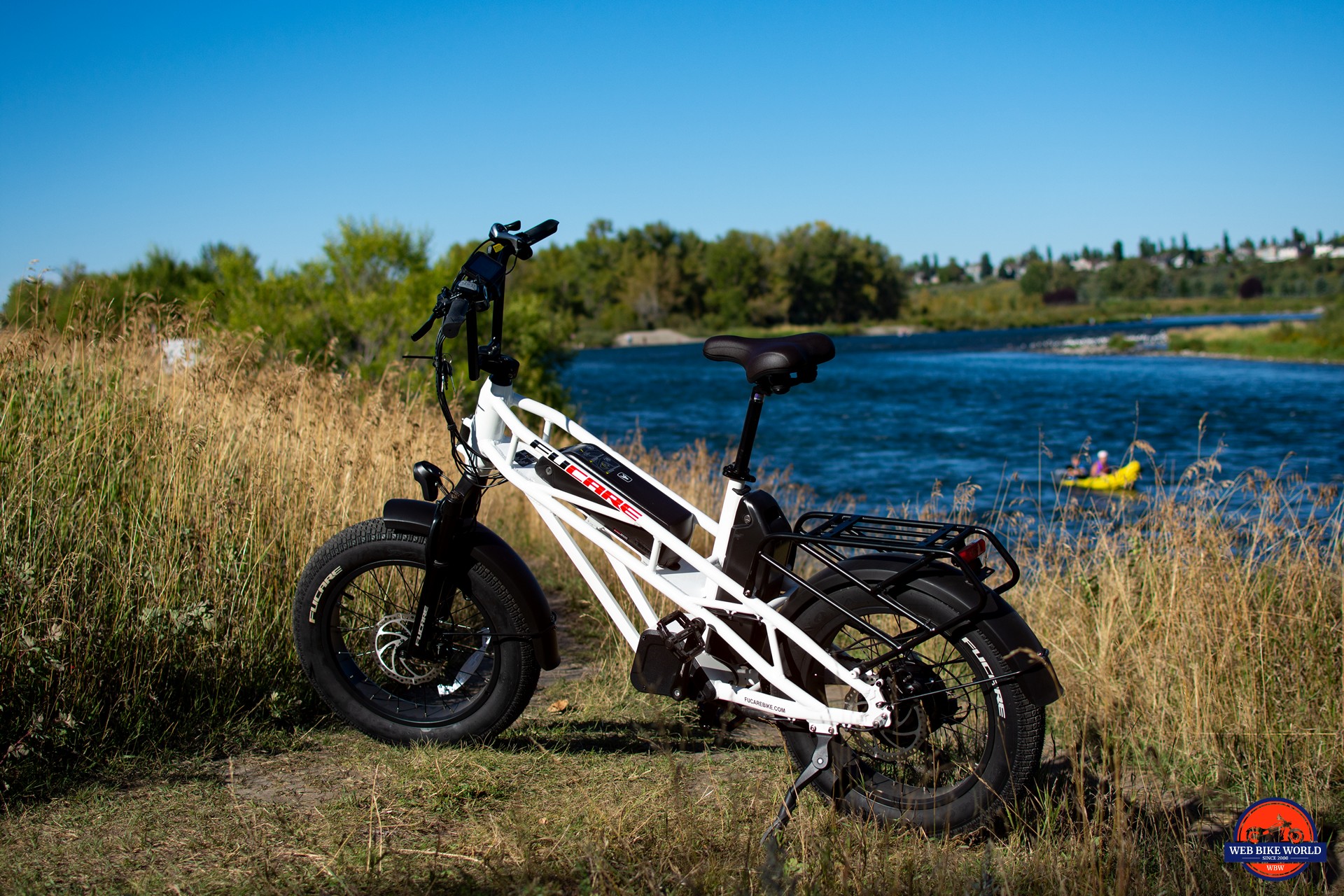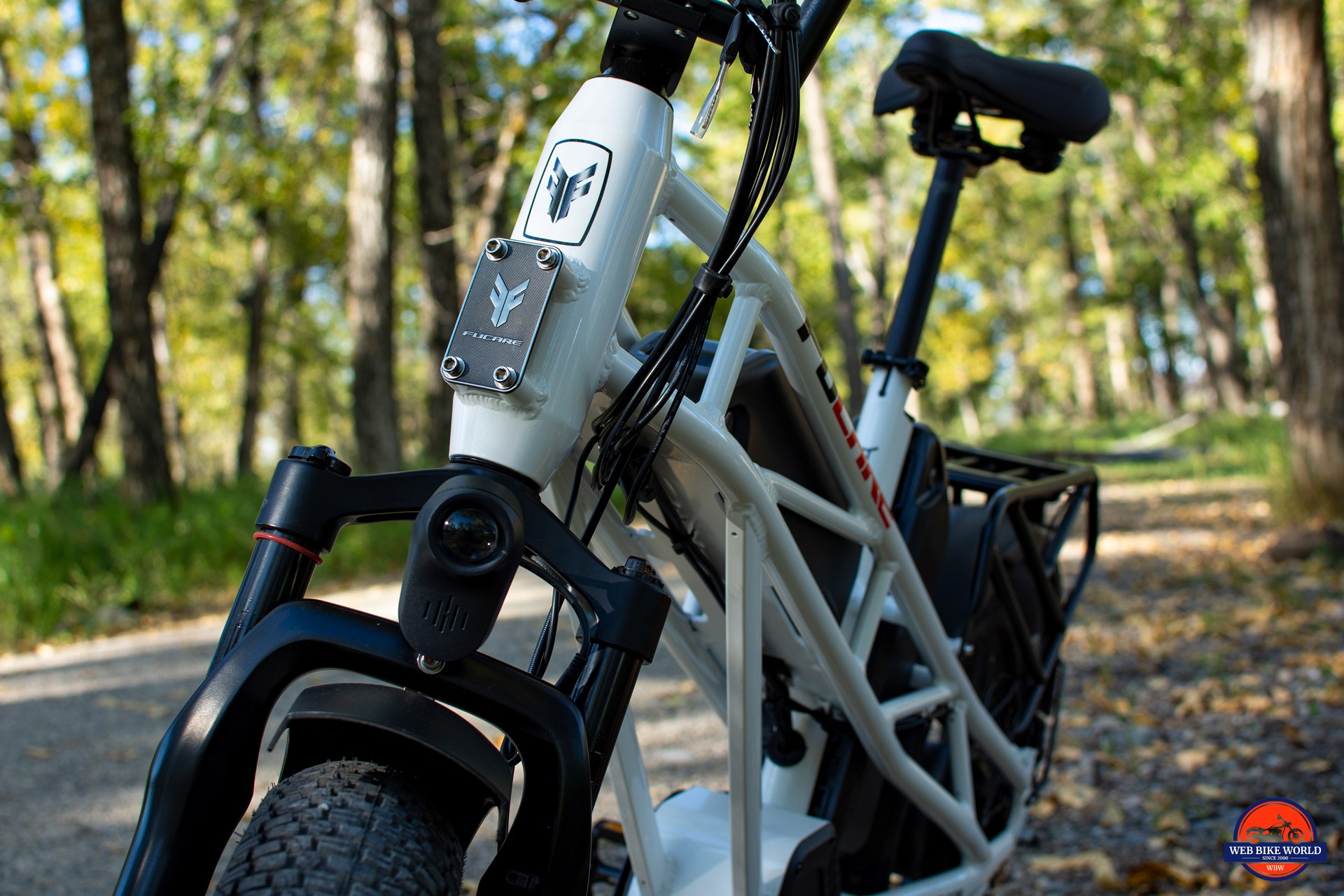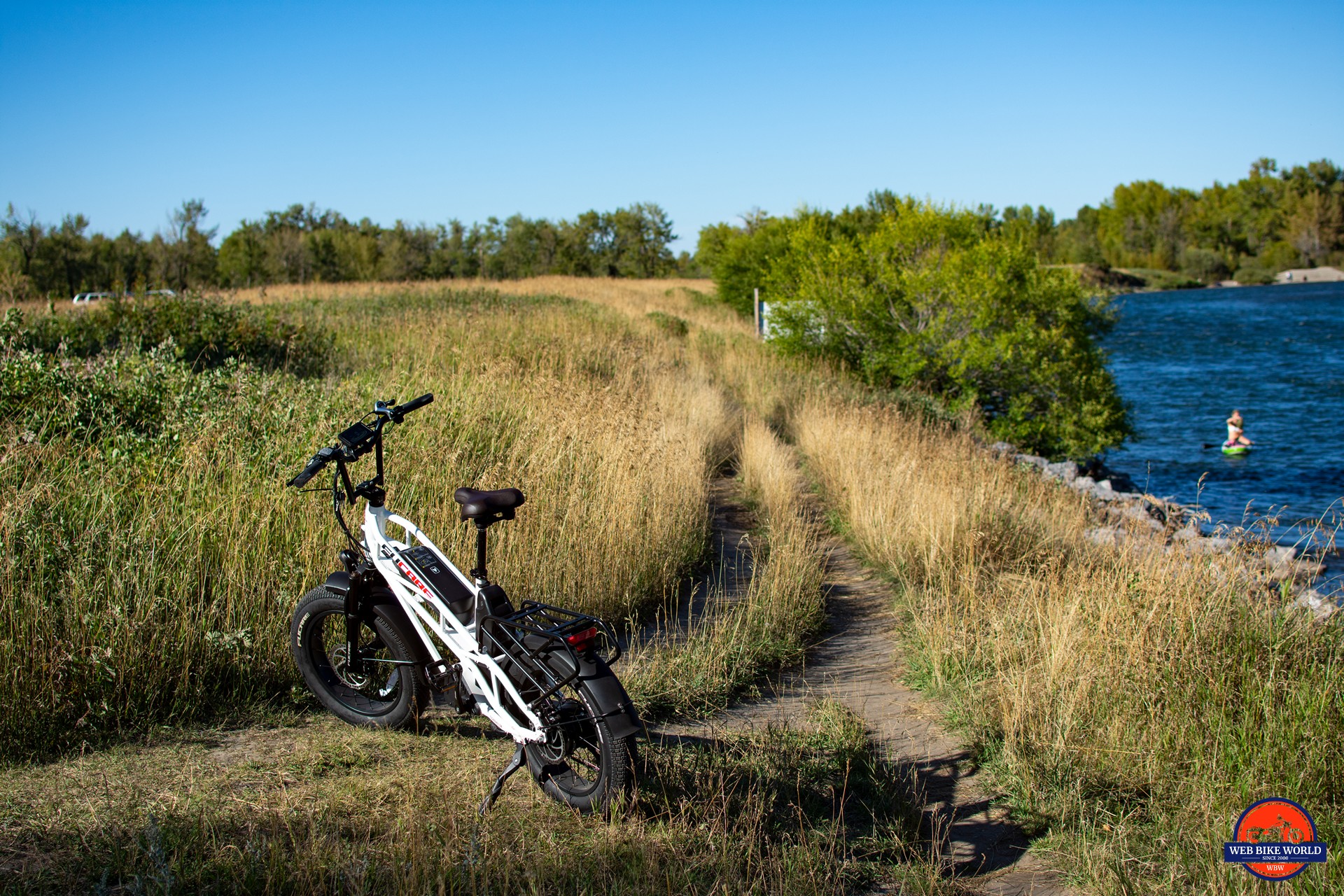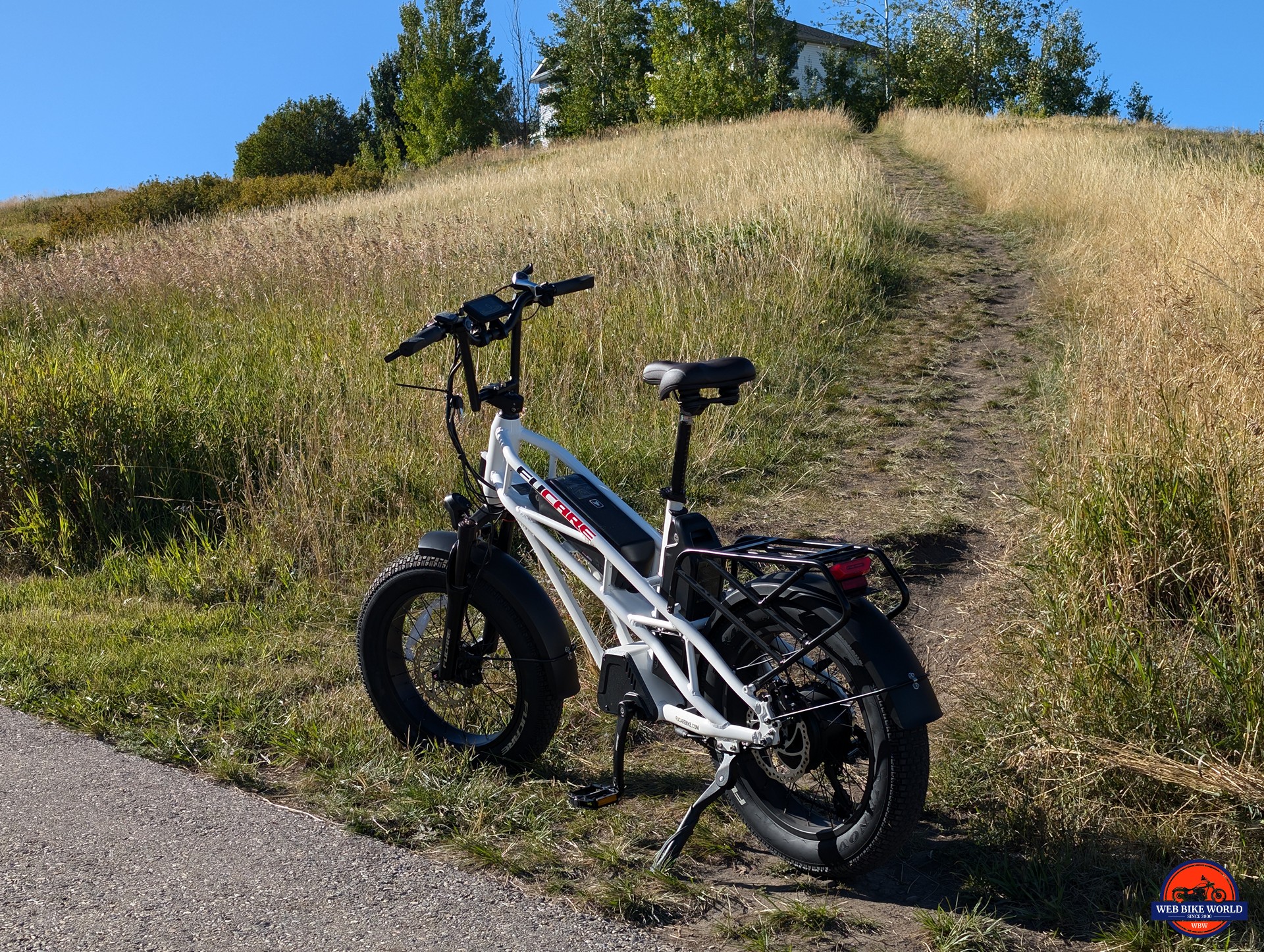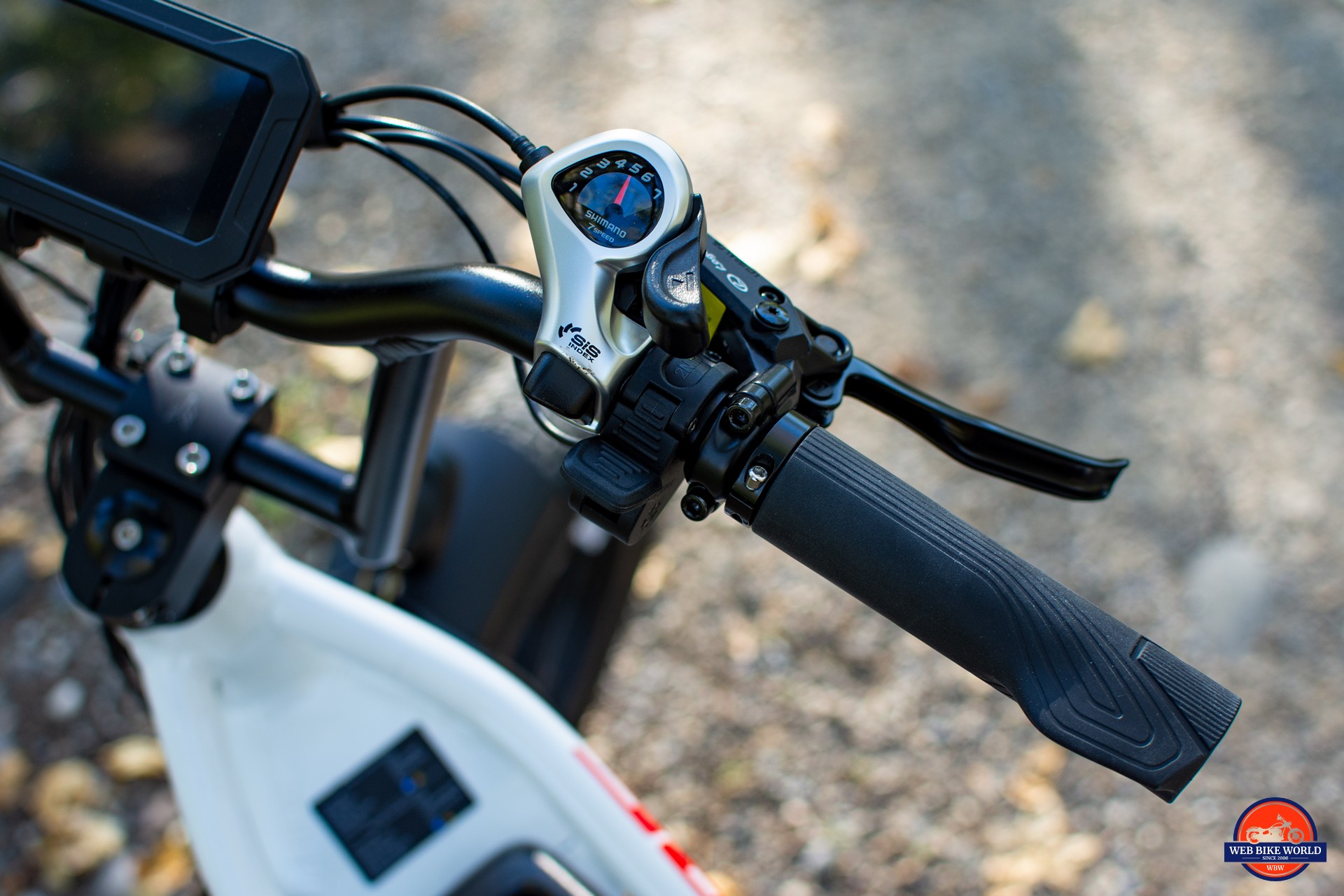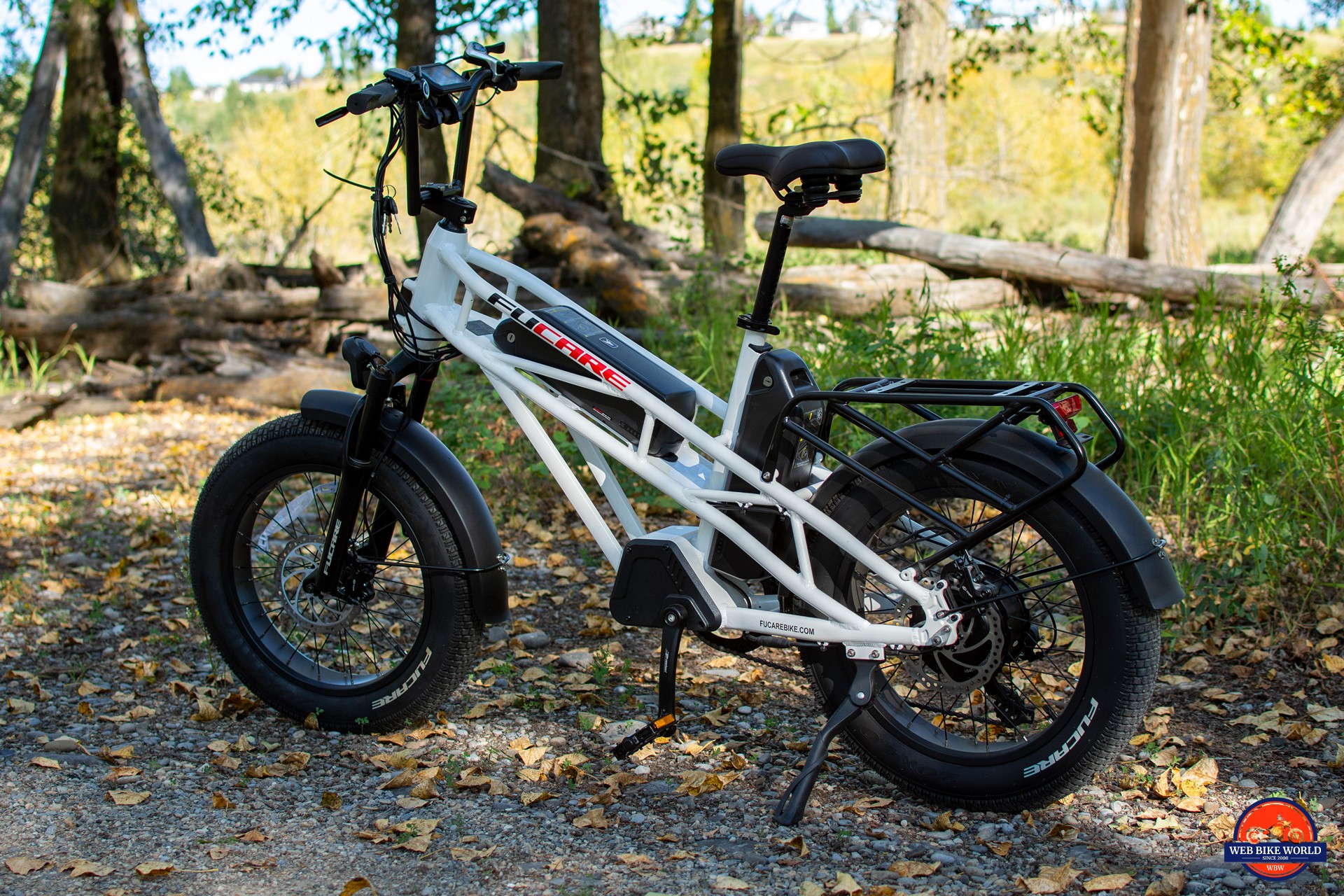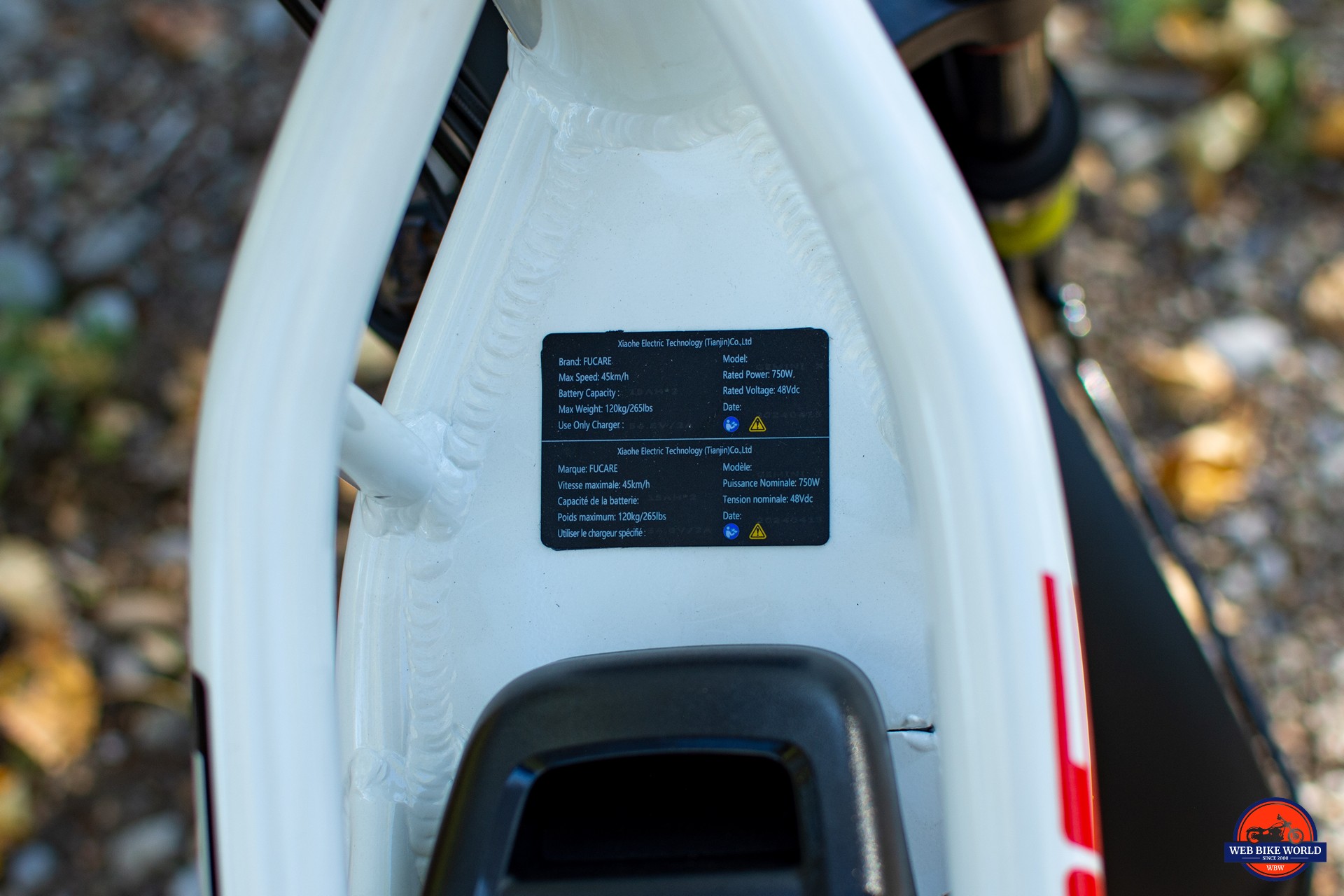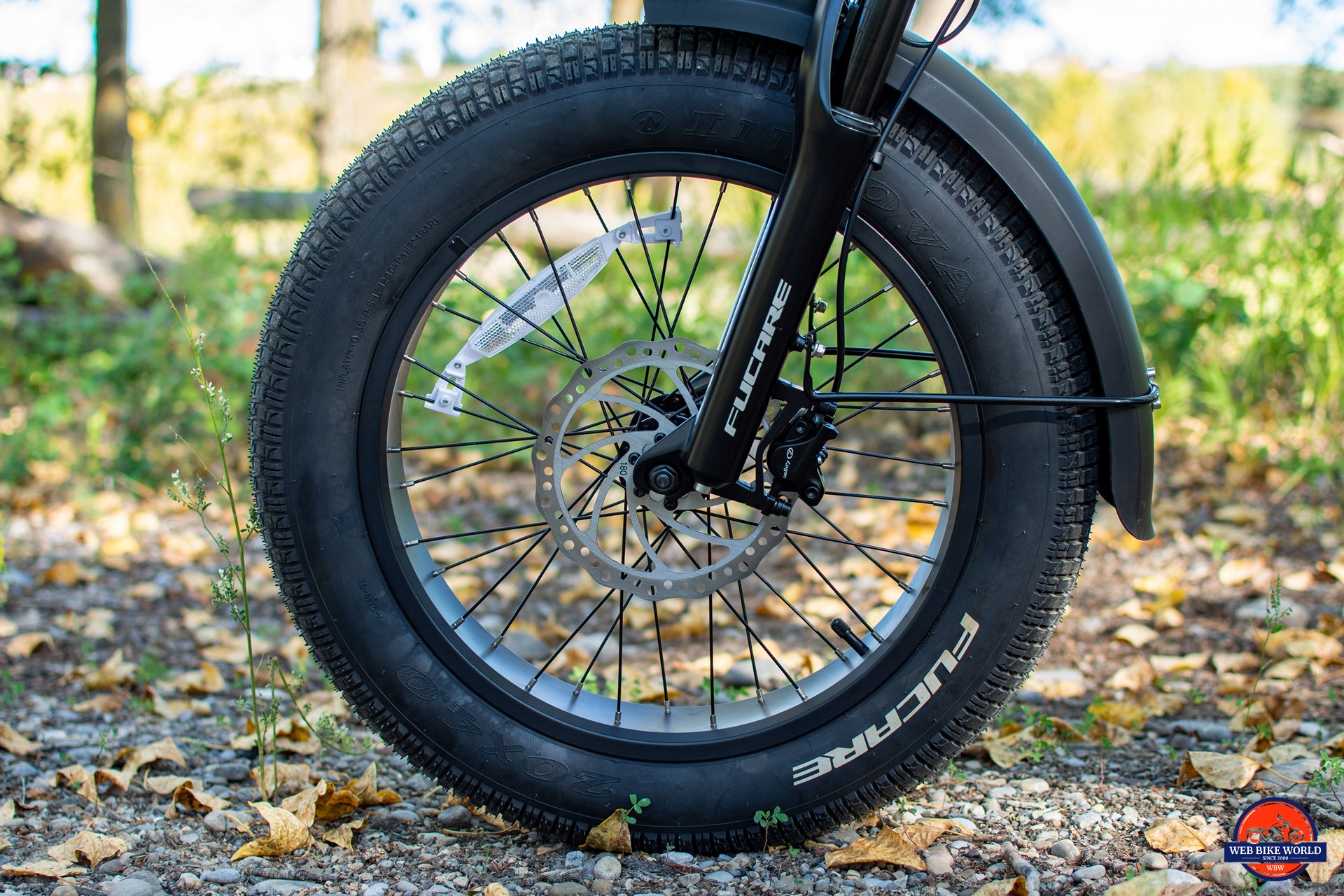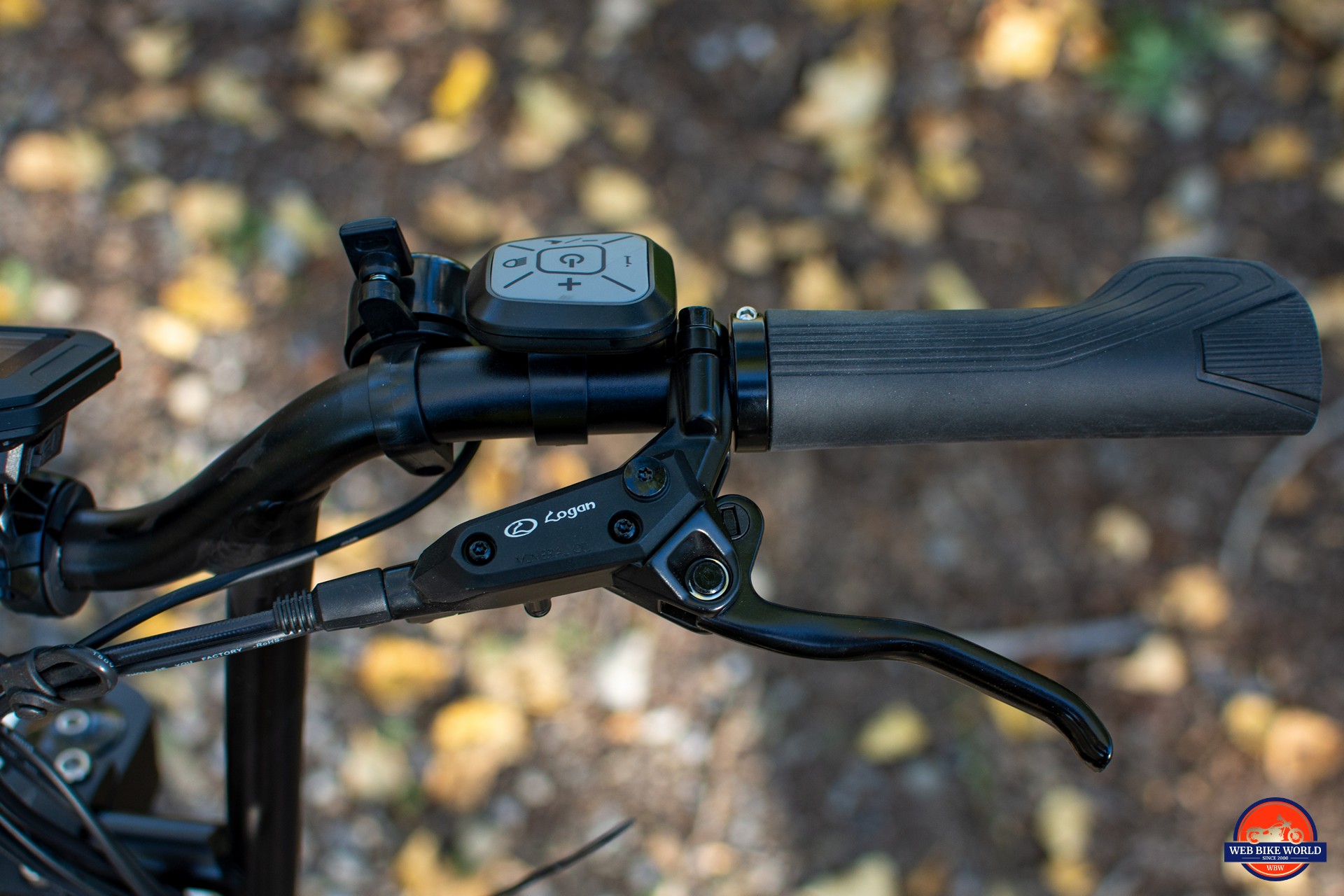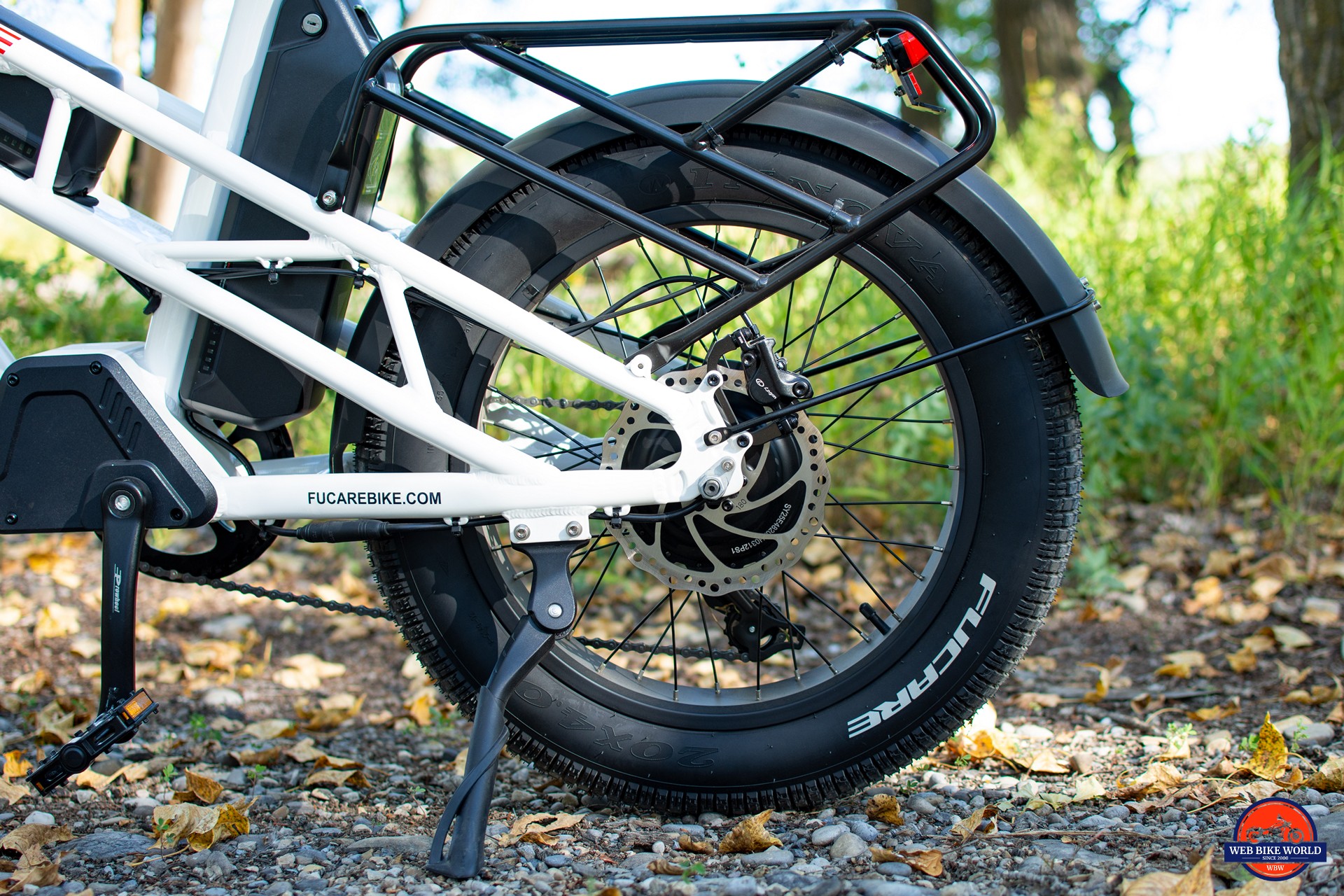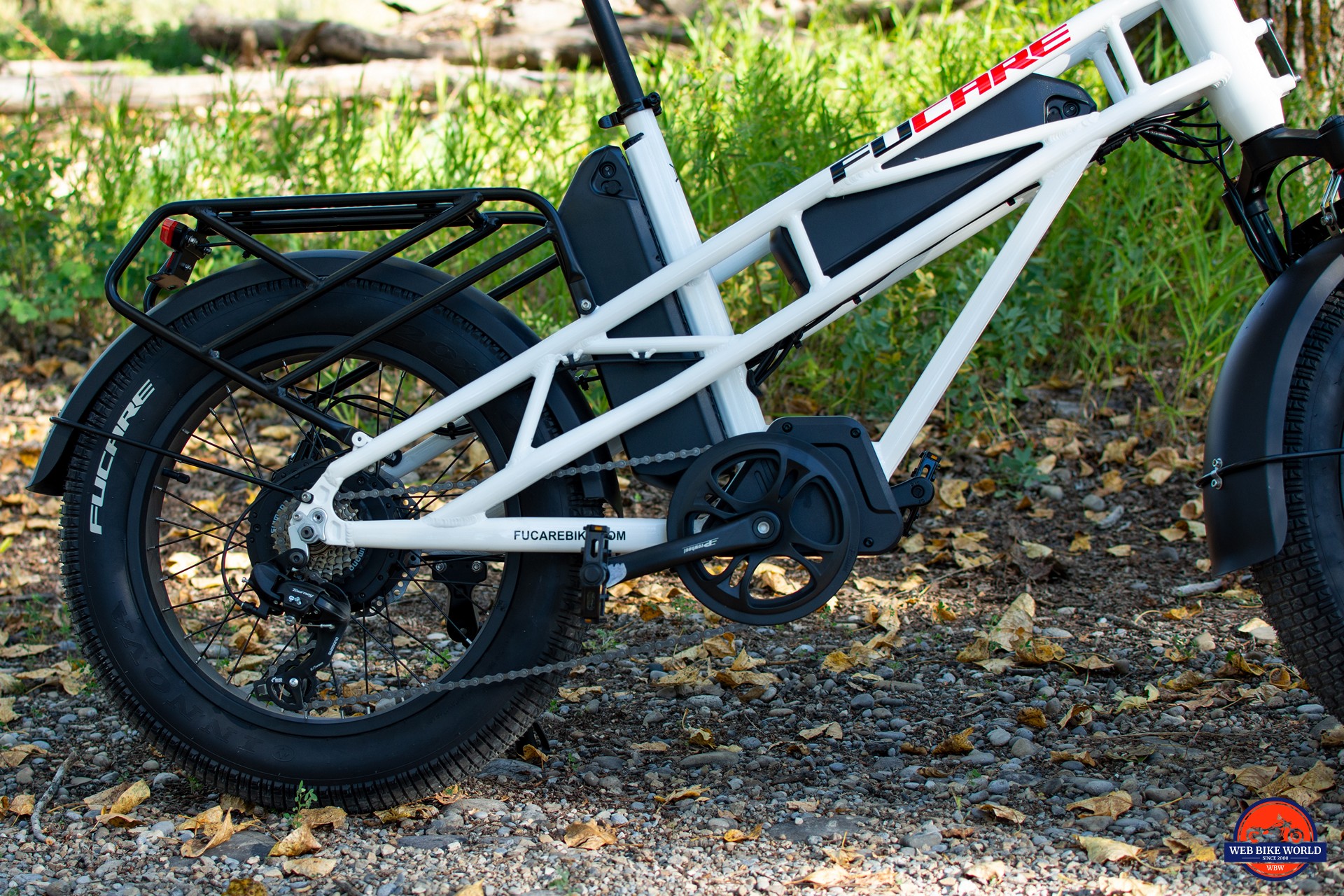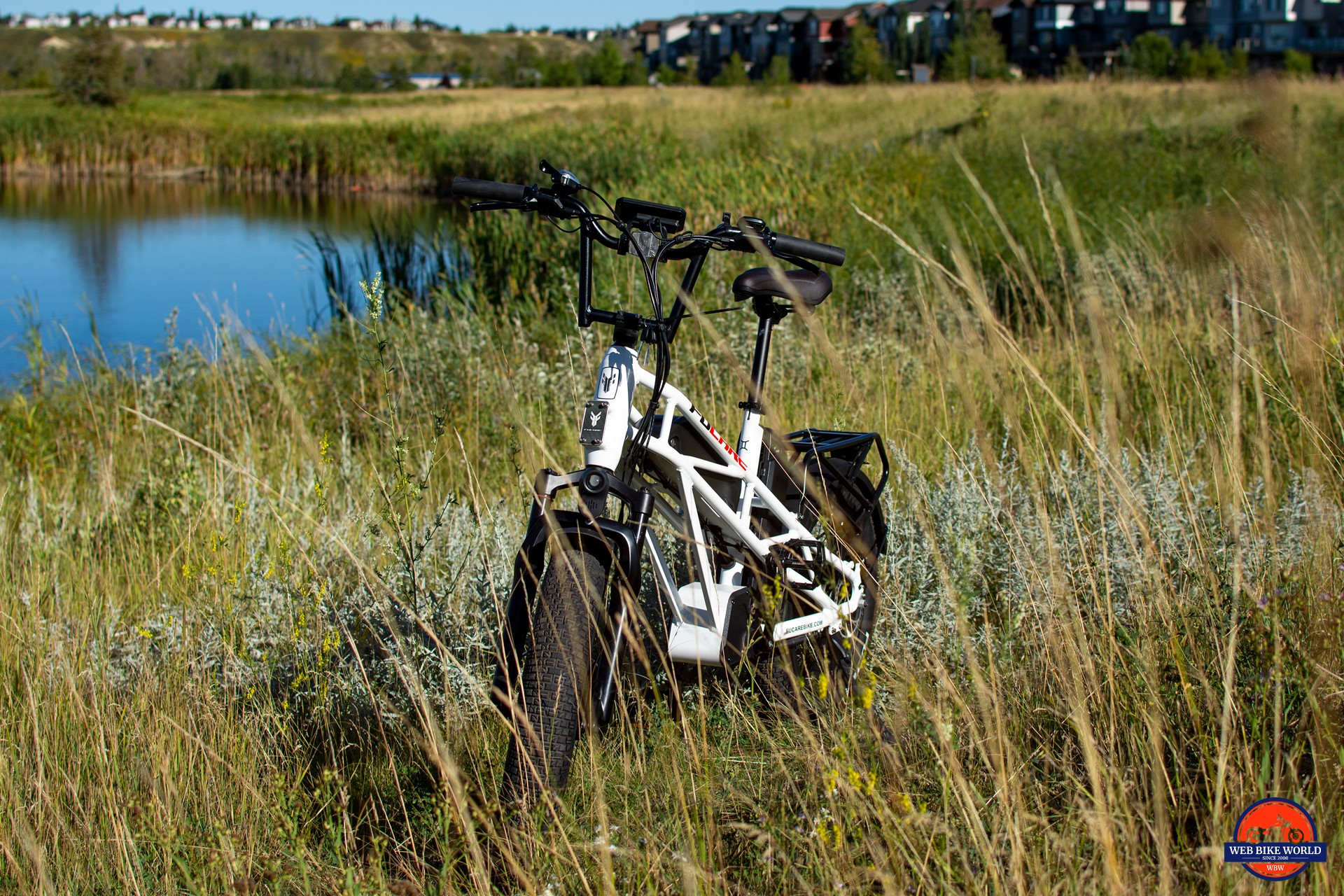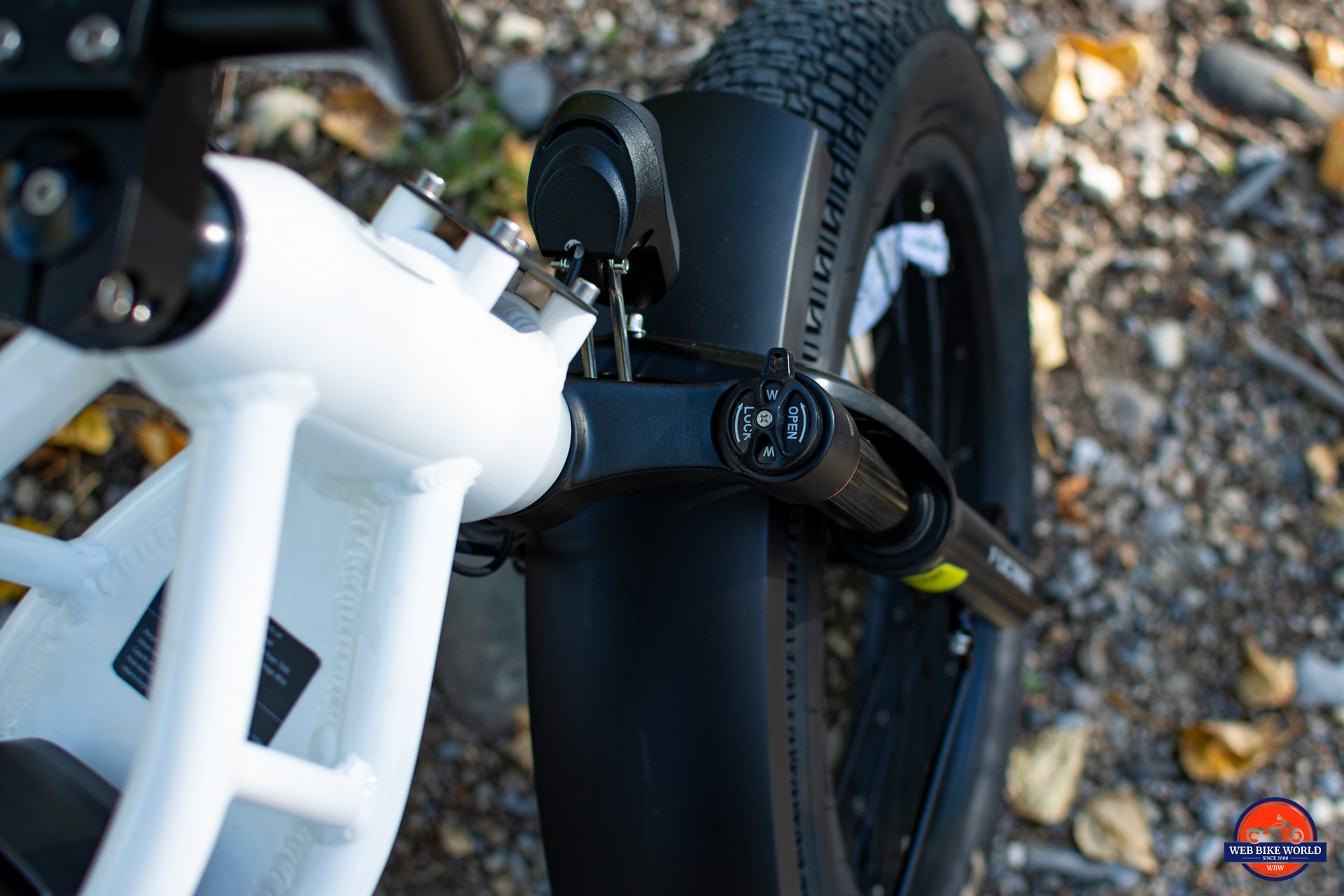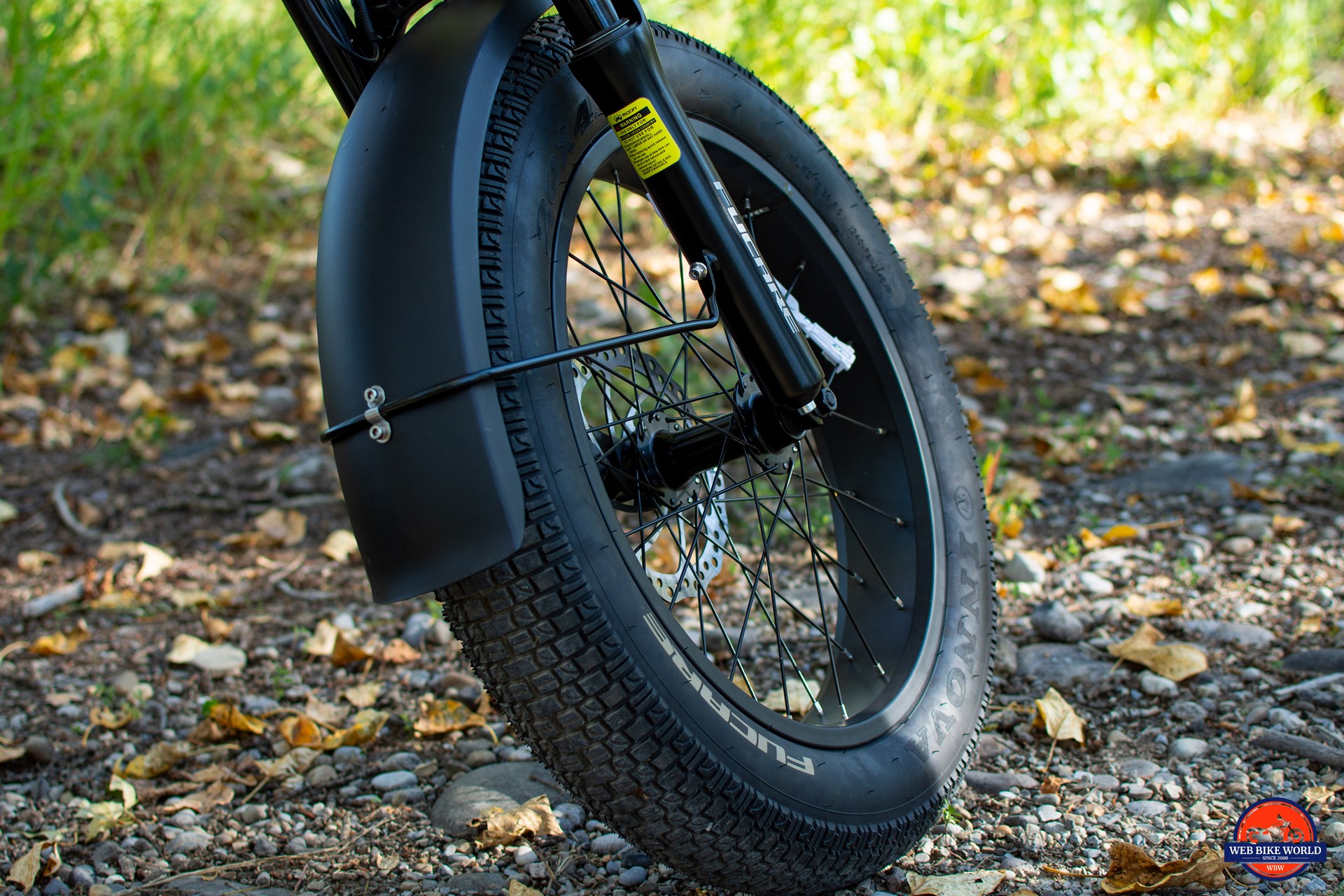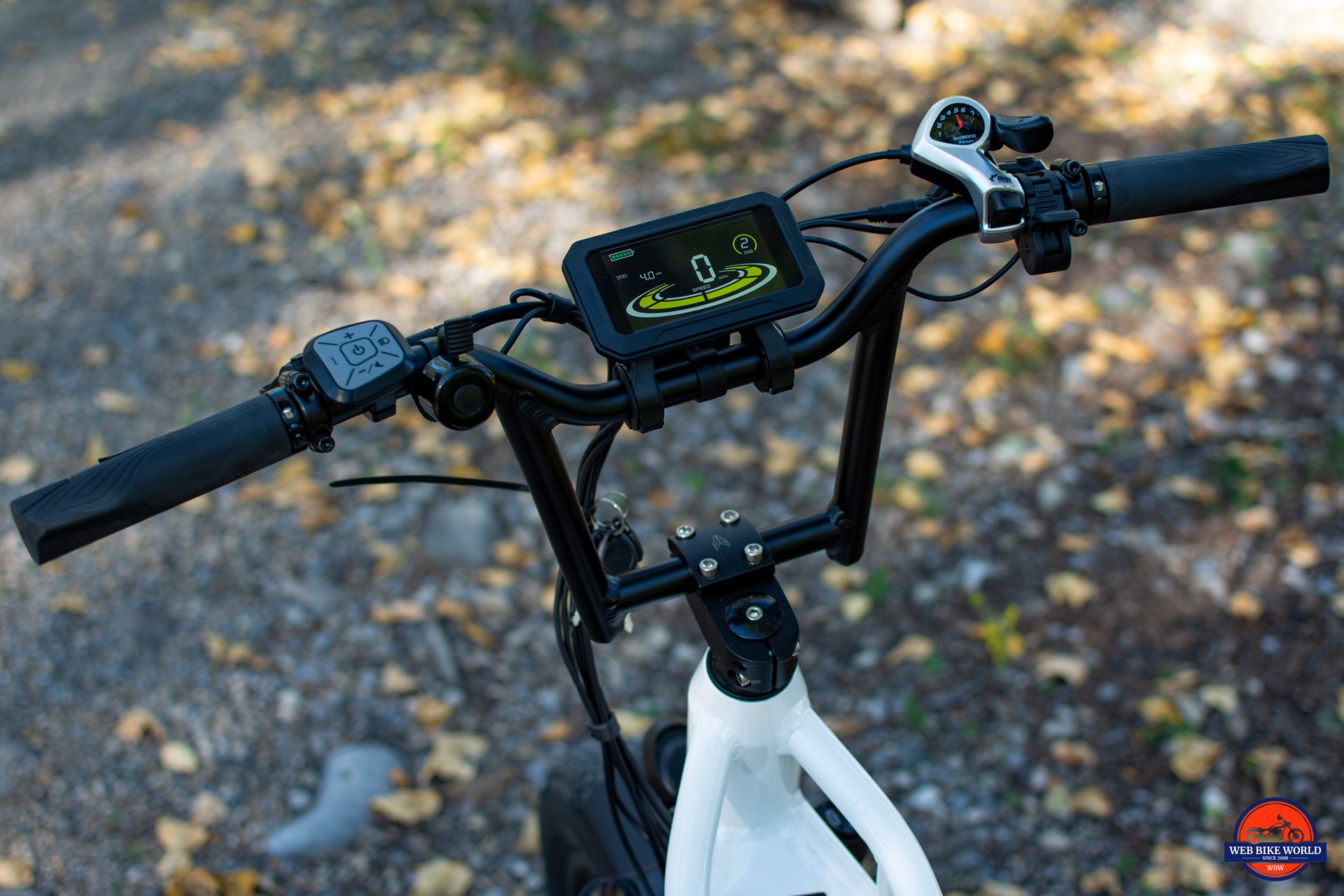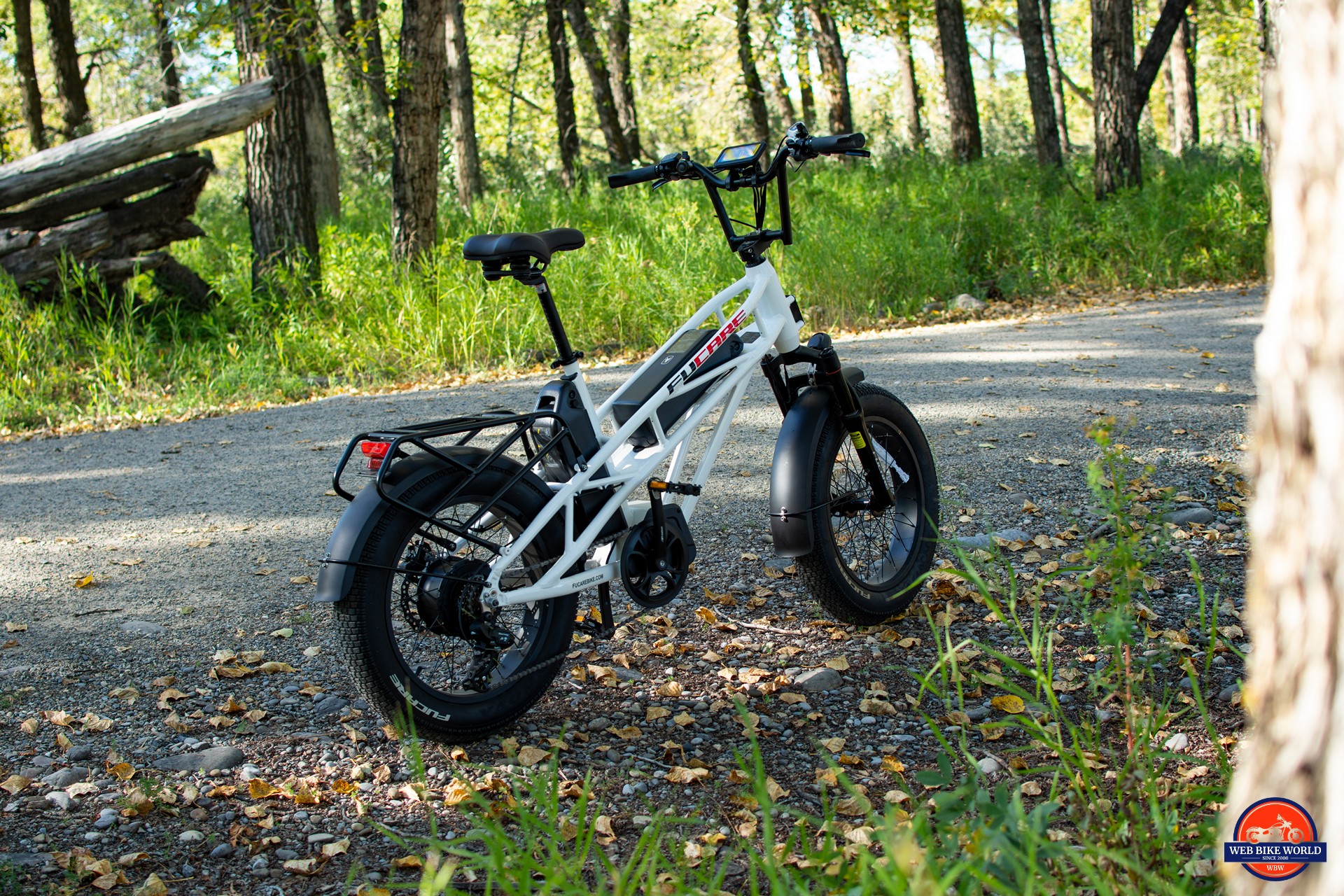The Fucare Gemini X is one of the most eye-catching ebikes I’ve seen or ridden. Its trellis frame deviates significantly from what your brain says a “bike” should look like, and for a bike that is “only” sporting a 750-watt hub motor, it has plenty of power to match its aggressive aesthetic.
Aside from the trellis frame, the most notable feature is the 30 Ah total battery capacity, provided by two 15 Ah battery packs. This dual-battery configuration is unusual, especially at this price. With 30 Ah (1,440 Wh) of battery capacity available, the Gemini X claims 50 – 120 miles (80 – 193 km) of range, though in reality, you’ll likely see around 50 miles (80 km) of actual usable range assuming you ride the Gemini X as it was intended (more on that later).
If you’re short on time, here are the five key things prospective owners should know about the Fucare Gemini X:
- The two 15 Ah batteries use Samsung cells. Each battery comes with its own charger. The chargers use a proprietary format, which may be problematic to replace in the future should you need new ones. Each battery must be plugged into its charger if you want to charge them simultaneously.
- The coil suspension fork with lockout is very springy and offers little cushion. It is objectively the worst suspension fork I’ve ever ridden on.
- Power and throttle response are excellent. The Gemini X accelerates swiftly and always has a lot of torque. It struggles up moderate hills on throttle alone but will happily keep a 28 mph (45 kph) pace over rolling terrain.
- The Gemini X is heavy at nearly 100 lbs, and it’s awkward to pedal due to the frame design. It is much better to pedal compared to a cafe racer or scrambler-style ebike, but it would prefer you ride it like a scooter or small motorbike vs. a traditional pedal bike.
- While competent on pavement, gravel, and packed dirt, the Gemini X struggles in loose gravel, sand, and off-road trails. It tolerates singletracks but does not want to ride on them for long.
Priced at $1,399 USD / $2,299 CAD, the Gemini X comes with a rear rack, front and rear fenders, and powered front/rear lights, making the entire package pretty affordable for an “assemble and go” experience. However, Fucare is using entry-level ODM components throughout, from the hydraulic brakes to what has to be the worst coil suspension fork I’ve ever ridden with.
You’ll probably find it lacking if you plan to ride the Gemini X like a bike. But ride it like the electric motorbike that it is, and you’ll appreciate it much more.
Words & Photography: Cameron Martel
Fucare supplied the Gemini X at no charge. We do not have a financial relationship with Fucare. All reviews are subject to our review policies. Products are scored based on our hands-on experiences with it. I have hands-on reviewed more than 30 ebikes and am an avid biking enthusiast.
2024 Fucare Gemini X Specifications
- MSRP: $1,399 USD / $2,299 CAD
- Where to Buy: Fucare website (Canada)
- Warranty: 30-day return policy, 1-year warranty on the bike and battery
- Top Speed: 28 mph / 45 kph (20 mph / 32 kph on throttle alone)
- eBike Class: Class 3 out of the box
- Range: Claimed 50 – 120 miles / 80 km – 190 km (wBW observed 50 miles / 80 km)
- Bike Weight: 90 lbs / 41 kg (including batteries)
- Weight capacity: 400 lbs (181.5 kg)
- Motor: SHENGYI 750 watt hub motor
- Torque: 80 Nm
- PAS: Cadence, 5 -levels
- Brakes: Generic hydraulic brakes w/ 180 mm rotors
- Gearing: Shimano Tourney 7-speed
- Battery: 2 x 48V 15 Ah (1,440 Wh)
- Wheels & Tires: 20” x 4” wheels and INNOVA tires
- Other: Headlight, powered taillight, front and rear fenders, rear rack
Fucare Gemini X Aesthetics & Design
The Gemini X looks more like a “minimalist electric dirt bike” than an electric bicycle. The thick trellis frame exposes the two batteries while mostly hiding wiring and components. Overall, the frame is of decent quality, though the welds are a bit chunky in places (something that is easy to overlook). It has absolutely no side-to-side flex or wobbliness—you have to give that trellis design some credit.
The motorbike-style handlebars also help sell the Moto design. The only thing the Gemini X is missing to really bring it home are side mirrors.
While the Gemini X certainly looks the part, you’ll be happy to know that the motor delivers on the design department’s check: smash the thumb throttle, and the Gemini X wastes no time getting to speed.
The frame design is undoubtedly novel, but it comes with some compromises you may not expect.
First, since the downtube isn’t a “tube,” wiring is nearly tucked underneath the frame instead of hidden inside. This isn’t the worst thing in the world, but it is worth looking at periodically to ensure that the wiring condition is still good and everything is still secured to the frame.
Second, the frame is much broader than a typical bike frame – fatter even than frames that integrate the battery into the downtube, such as the frame on the Himiway D5 – and you’ll likely rub against it as you pedal unless you make a concerted effort to widen your stance somewhat.
But the Gemini X was intended to be throttled, with minimal pedal action from the rider. From that perspective, it does its job well.
What’s the Fucare Gemini X Like to Ride?
For casual riders, the Gemini X brings a mixture of an electric moped and an electric bicycle (that is heavy on the moped side of the equation); it isn’t a bike that you want to ride like a pedal bike. Between the heavy weight, sub-optimal frame ergonomics, and low-end components used throughout, you won’t find much joy riding the Gemini X like a bike.
Lean into the electric moped or scooter angle, however, and the Gemini X squares up much more favorably.
The 750-watt motor might “only” output 80 Nm of torque on paper, but in practice, the Gemini X accelerates with the best of them. The only other hub motor ebike I’ve ridden to date (and I’m 30+ deep at this point) that accelerates as aggressively as the Gemini X is the HeyBike Brawn, which also sports a 750-watt rear hub.
But no matter how you slice it, the Gemini X is a mixed bag that requires a small list of concessions from its rider.
For example, in the photo above, while the Gemini X would begrudgingly climb the hill on throttle alone, a fair bit of pedaling was required to get it there comfortably. And, when it was time to turn around, the Gemini X did not enjoy the trip back down. If it were 30 lbs lighter (or if I was ~50 lbs lighter), it’d be much more manageable, but at 100 lbs, the 180 mm rotors and generic hydraulic brakes, alongside the bargain-basement coil fork, aren’t up for the job.
Highlights
- With ample power on tap and 30 Ah of total battery capacity, you can feel good about throttling along wherever you want. It has the power and range to offer a satisfying ride. Expect around 50 miles / 80 km of all-electric range, assuming you pedal along when climbing hills, and closer to 75 miles / 120 km if you contribute a good portion of pedal power.
- Due to the frame’s weight and the slightly forward riding position, cornering with the Gemini X requires more lean than other ebikes I’ve ridden and is more akin to what you’d expect on a scooter or small motorcycle. As someone who has owned eight motorcycles over the past 15 years, I like leaning… leaning is good! To me, this is a feature and not a bug.
- The 4” wide INNOVA tires perform well on the street and never feel lacking in grip. They didn’t perform as well on packed dirt and gravel, but they did the job.
- The large display, while basic, is easy to see and sufficiently bright.
- The included rear rack feels robust, and there is a mounting point on the front of the frame for a front rack. The bike has a total load capacity of 400 lbs, so you could feasibly turn this into a respectable cargo ebike.
Room for Improvement
- The bike is very bouncy on grass and easy singletracks. The front suspension is more pogo-stick than suspension, and the Gemini X doesn’t have much cushion over rougher terrain. It even makes an audible “TWANG” when switching from locked out to open. There is minimal actual adjustment here: it’s either on or off.
- The stock handlebar configuration places the throttle and the gear shifter practically on top of each other, making the gear shifter awkward to use. To improve accessibility, you’ll want to realign the right bar or move the throttle to the left bars (which I’ve opted to do since the initial photoshoot).
- The seat is slightly more forward than most bikes, so your legs will rub against the frame as you pedal. This is the biggest reason why the Gemini X is better viewed as an electric scooter vs a bicycle. This is generally a mild nuisance, but as soon as you need to really pedal (such as when climbing a steep hill), the frame manages to get in your way. Annoying.
- The entry-level groupset, paired with a surprisingly aggressive cadence-sensing pedal-assist system, emphasizes that the Gemini X is meant to be driven more than ridden.
- Repeated bouts of aggressive braking will induce brake fade much faster than expected. Remember, this bike weighs almost 100 lbs on its own, and while the generic hydraulic brake setup is much better than a more traditional mechanical brake configuration, these generic parts are used to help cut costs. The impact of those savings is felt here.
- The pedal assist system wants to rocket you to its predetermined speed. A half turn of the crank will result in several seconds of acceleration, and at higher speeds, you’re basically ghost-pedaling with the bike doing almost all the work. This may be fine from a commuting perspective, but this dynamic certainly takes the nuance out of the riding experience. You can adjust the PAS from 5 levels to 9, which improves this somewhat.
Fucare Gemini X Build Quality & Components
To achieve its sub-$1,400 price, the Gemini X uses generic/OEM components, including the SHENGYI hub motor. Fucare did choose to use hydraulic brakes instead of mechanical ones, but otherwise, every component equipped on the Gemini X—with the notable exception of the batteries—is entry-level.
Another oddity: the Gemini X is advertised with a 400-lb load capacity, but the sticker on the frame says 265 lbs. Given the frame, I imagine that 400 lbs is the correct figure, and the sticker just slipped by the QA department…
Brakes
The Logan hydraulic brake setup is hard to pin down. Logan doesn’t appear to have a consumer-facing website, and most of the information on the brand comes from e-commerce store listings.
The setup appears to be a knockoff version of the Shimano Alivio series. According to my local bike mechanic, the knockoff brands have been improving, but it’s hard to tell how the Logans will hold up long-term.
Many ebikes I’ve reviewed have come with generic brakes, and none have presented any problems during the limited testing I am able to extend to them, but this says nothing about expected longevity. It’s hit or miss.
The good news is that replacement Logans are inexpensive—around $100 or so for the kit. Upgrading to a “proper” brake setup is also affordable, with the brand-name Alivios costing under $200 for the entire setup.
The Logan’s performed fine during daily riding, but came up wanting somewhat when exposed to aggressive riding. Brake fade was noticeable, as was some pulsing/vibrations from the rotor. I can appreciate that having to slow 100 lbs of ebike and 210 lbs of ebike reviewer puts considerable strain on the system.
Overall, the brakes are adequate for normal riding circumstances. Long-term durability is unknown, but these should be an easy and affordable replacement when the time comes.
Drivetrain & Groupset
The Shimano Tourney groupset is typical for an inexpensive ebike like this, and given the lackluster riding dynamics due to the frame, I don’t think its inclusion here is a bad thing.
You have 7-speeds on tap and seven very “don’t climb serious hills please” gears in the rear. The Gemini X can be pedaled on flat terrain sans motor easily enough, but as soon as there is any degree of gradient, you’ll be engaging the motor.
I would want to avoid getting stranded somewhere at the bottom of a valley with both batteries dead. That ride up would be grueling.
Motor, PAS, & Throttle Performance
The bike’s highlight is the motor + throttle combination, which provides ample power and is ready to go anytime.
The throttle response from the SHENGYI 750-watt rear hub motor is excellent. It’s easily my favorite part of the Gemini X: you have instant and adequate power anytime you’re in PAS 3 or higher.
The throttle speed is limited based on PAS settings, with the speed limit matching what you have set for each level.
Out of the box, the Gemini X ships with PAS levels ranging from 0-5, but you can adjust this to be 0-3, 0-7, 0-9, or 1-9. When you change the number of assist levels, you can also set the speed for each one to suit your preferences.
I find that 0-7 PAS levels is a better choice, as you can better pair motor output with your intended level of pedaling. It’s still a clunky cadence configuration compared to other ebikes, but it’s much better with the additional two levels.
I easily got the Gemini X to a cruising speed of 28 mph / 45 kph on throttle alone. Climbing moderate hills, the speed will fall to closer to 12 mph / 19 kph, but adding a bit of pedal power makes it much easier to climb.
Suspension
The no-name suspension is the worst I’ve ridden with. It lacks the adjustability that even the cheapest forks usually provide, instead giving you a choice: on (open) or off (locked).
The suspension is reasonably stiff when locked with almost no up/down play. Due to how poorly the suspension performs, I’ve opted to leave the suspension locked and instead deflate the tires somewhat to provide additional cushion.
When open, the suspension bounces freely. It never feels uncontrollable, but it also never feels plush or comfortable.
If this is your first ebike and you haven’t ridden other bikes with superior suspension, then I suppose it’s good enough. In my case, if I really loved the Gemini X and wanted to keep it long-term, I’d be looking to swap out the fork in favor of something that can better handle the weight and riding style of the bike.
Wheels & Tires
There isn’t much to say about the 20”x4” wheels and INNOVA tires. The tread pattern for the INNOVA’s is decidedly on-road. You’ll get adequate performance in “light” off-road situations, such as a packed dirt path or on a grass field, but if you intend on riding primarily on the dirt, you’ll want a tire better suited for the job.
The sidewall states a max of 35 PSI. At that PSI, with the suspension being what it is, the ride felt very choppy and stiff. I am much happier with the tires at 18 PSI. Sure, you use up a lot more battery at lower pressures like that due to increased rolling resistance/traction, but when you’ve got 30 Ah of total capacity… why not?
Display & Settings
The color display is a step above what you usually see on entry-level models, but a step below the color displays that many direct-to-consumer and premium brands are using these days. However, despite not being “as good” as other displays, it’s still plenty good for what you need it for.
The display can be adjusted between MPH and KPH, alongside other adjustable settings. This video is handy to guide you through what you can do with the display, as the menu is not exactly intuitive.
Also, out of the box, my display was set to a 24″ tire diameter. I corrected this to 20″ and didn’t notice much difference in performance, but you should absolutely review the settings before your first ride.
Adjusting the Display Settings
- Pres the + and – simultaneously buttons for 5 seconds to access the menu.
- Use the + / – buttons to navigate the menu, and the i button to select options.
- The menu is not intuitive, and uses P1 – P9 to designate the functions you are viewing changing.
- P1 = Metric or imperial units (MPH or KPH)
- P2 = Voltage. This should be set to 48V.
- P3 = Pedal assist modes. Adjust the number of assist levels (and their associated speeds) here.
- P4 = Wheel diameter. Ensure this matches your wheel size.
- P5 = Speed magnet settings. Do not change this.
- P6 = Speed limter.
- P7 = Controller current settings. Do not change this.
- P8 = Pedal assist sensor settings. Do not change this.
- P9 = Throttle settings.
- PA = Password (default is 1212)
- PB = Auto sleep settings
- To return to factory defaults, press and hold the + and light buttons in the menu.
The Gemini X is a Competent Electric Moped, But Those Looking for a Bike Experience Will Want to Pedal Elsewhere
With its dramatic visuals and unconventional battery configuration, I had high expectations for the Gemini X. For the most part, the Gemini X delivers – it certainly does from a power and range perspective – but it has a few weaknesses that you should consider before buying.
Importantly, I lean more toward the “bicycle” side of the ebike camp. Plenty of people love the Gemini X for being a powerful and impactful electric moped. If the moped experience is what you’re seeking, you can add my name to the list of people recommending it for that type of riding.
However, its weight, unusual frame configuration, sub-optimal pedaling position, and entry-level components ensure you’ll never enjoy pedaling this bike.
Riders seeking an affordable, long-range ebike that performs well on the throttle will find the Gemini X to be a great option. It out-moped’s every moped-style ebike I’ve ridden, is much more comfortable than a moped frame style is, and is also more usable thanks to its rear rack, optional front rack, and hefty 400 lb weight capacity.
The Gemini X would be a great performer with an improved fork and better cadence-sensor tuning. As is, it’s an adequate entrant that relies heavily on the novelty factor that the trellis frame and dual battery configuration lend it.
2024 Fucare Gemini X Review
Review Summary
The trellis-frame’d Fucare Gemini X makes a big visual statement and is equipped with the motor to give it the grunt to match. Its ~100 lb weight and awkward riding dynamics make the Gemini X more scooter than bicycle, and with 30 Ah of battery capacity, it’s good for around 50 miles (80 km) of throttle-heavy riding. Keep it to man-made paths and avoid stressing the “suspension” fork!
Pros
Very powerful motor overdelivers compared to most of its 750-watt peers
Eye-catching aesthetic featuring an exposed trellis frame
Dual 15 Ah batteries provide tons of power capacity
Included rear rack and fenders make the Gemini X suitable for daily riding
Throttle-only range of 50 miles / 80 km, and up to 75 miles / 120 km of range with some pedal power
Cons
Very heavy at 100 lbs
Uncomfortable riding position
Terrible coil suspension fork
No off-road chops whatsoever
Cramped cockpit on the right bars


